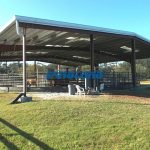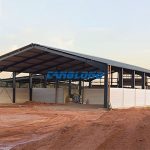Cost-benefit analysis of metal agricultural storage buildings
In modern agricultural production, the choice of storage buildings plays a vital role in the operational efficiency, cost control and sustainable development of the farm. With the advancement of metal material technology, metal agricultural storage buildings have gradually become the first choice for many farmers. This article will delve into the cost-benefit analysis of metal agricultural storage buildings to help farmers better understand their economic advantages and long-term value.

Characteristics of metal agricultural storage buildings
Metal agricultural storage buildings are typically constructed of steel or aluminum and have several core features:
- Durability: Metal materials have excellent corrosion resistance and wind resistance, and can withstand harsh climate conditions, ensuring long-term use of the building.
- Low Maintenance: Metal buildings are relatively low-maintenance, typically requiring only regular inspections and cleaning, avoiding the rot and insect infestation issues common with wooden structures.
- Rapid construction: Prefabricated components of metal buildings can be manufactured in factories and assembled on site, significantly shortening construction time and reducing labor costs.
- Flexibility: Metal buildings can be expanded or modified as needed to accommodate different storage needs and functional requirements.
Cost analysis
1. Initial investment
The initial investment in a metal agricultural storage building typically includes material procurement, construction costs, and design fees. While metal materials may cost more per unit than traditional materials such as wood, their durability and low maintenance costs can offset the high initial investment.
- Material cost: The price of metal materials is highly volatile, but with the advancement of technology and the expansion of production scale, the overall cost gradually decreases.
- Construction cost: Due to the rapid construction characteristics of metal buildings, the construction time is short and the labor cost is relatively low.
2. Operating costs
Operating costs mainly include energy costs, maintenance costs and insurance costs.
- Energy efficiency: Metal buildings are often designed with thermal insulation and ventilation in mind, which can reduce energy consumption for heating and cooling to some extent.
- Maintenance costs: Metal buildings have lower maintenance requirements. Compared to wooden buildings, metal buildings do not require frequent painting, repair and replacement.
- Insurance Cost: Because of the fire and wind resistance of metal buildings, insurance companies often reduce the cost of insuring this type of building.
3. Economic benefits
The economic benefits of metal agricultural storage buildings are reflected in many aspects:
- Long-term return on investment: Although the initial investment is higher, the durability and low maintenance costs of metal buildings provide a high return on investment over the long term.
- Improve production efficiency: The flexible design and rapid construction of metal buildings can improve the efficiency of agricultural production, reduce downtime, and increase crop or product turnover.
- Versatility: Metal storage buildings can be adapted to a variety of uses, such as storing machinery and equipment, crops, feed, etc., maximizing space utilization.
Sustainability considerations
In modern agriculture, sustainability has become an important consideration. Metal buildings demonstrate their sustainability in the following ways:
- Material recyclability: Metal materials can be recycled at the end of the building’s life cycle, reducing resource waste.
- Energy-saving design: Many metal buildings incorporate energy-saving designs, such as natural ventilation and lighting, which reduce energy consumption.
- Reduced environmental impact: The construction process of metal buildings generally has a lower impact on the environment, especially in terms of construction waste and soil disturbance.
Case analysis
In many countries, farmers have begun adopting metal agricultural storage buildings. For example, on a large farm in the American Midwest, metal storage buildings were selected to store farm machinery and seeds. By using metal buildings, the farm not only saved 30% of maintenance costs, but also improved work efficiency and shortened the downtime of agricultural machinery.

In conclusion
Taken together, metal agricultural storage buildings show significant advantages in terms of initial investment, operating costs and long-term economic benefits. Their durability, low maintenance and quick construction make metal buildings an ideal storage solution in modern agriculture. Through reasonable cost-benefit analysis, farmers can better evaluate the value of metal agricultural storage buildings, make choices that meet their own needs, and contribute to the sustainable development of agricultural production.













